Eniwetok, part of the Marshall Islands and an atoll in the Pacific just north of the equator, was considered a strategic target during the “island hopping” campaign of World War II. Operation “Catchpole,” the effort to capture the atoll from the occupying Japanese, took place in mid-February 1944. During the operation, Marines and Army infantry, supported by members of the Coast Guard, assaulted the island of Engebi within the atoll. The battle for the island was devastating for the enemy garrison of 1,200 Japanese troops and only 19 of the enemy defenders surrendered.
During the battle, marine communications specialists took heavy casualties requiring volunteer Navy and Coast Guard radiomen to serve ashore. One of those Navy 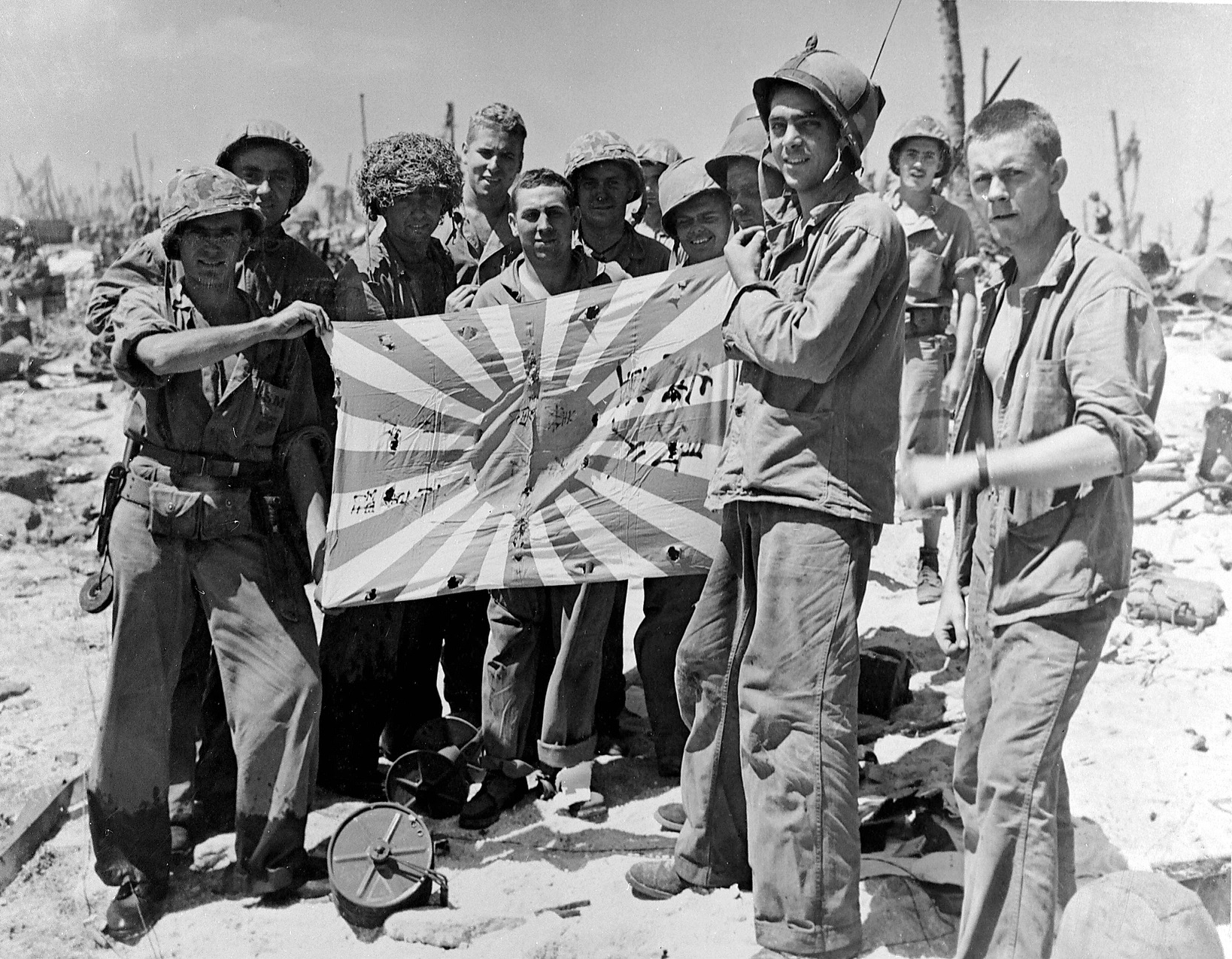 volunteers, located on the right in the picture left, can be seen holding a Japanese flag taken on Engebi. Once it had been cleared and stamped by military intelligence
volunteers, located on the right in the picture left, can be seen holding a Japanese flag taken on Engebi. Once it had been cleared and stamped by military intelligence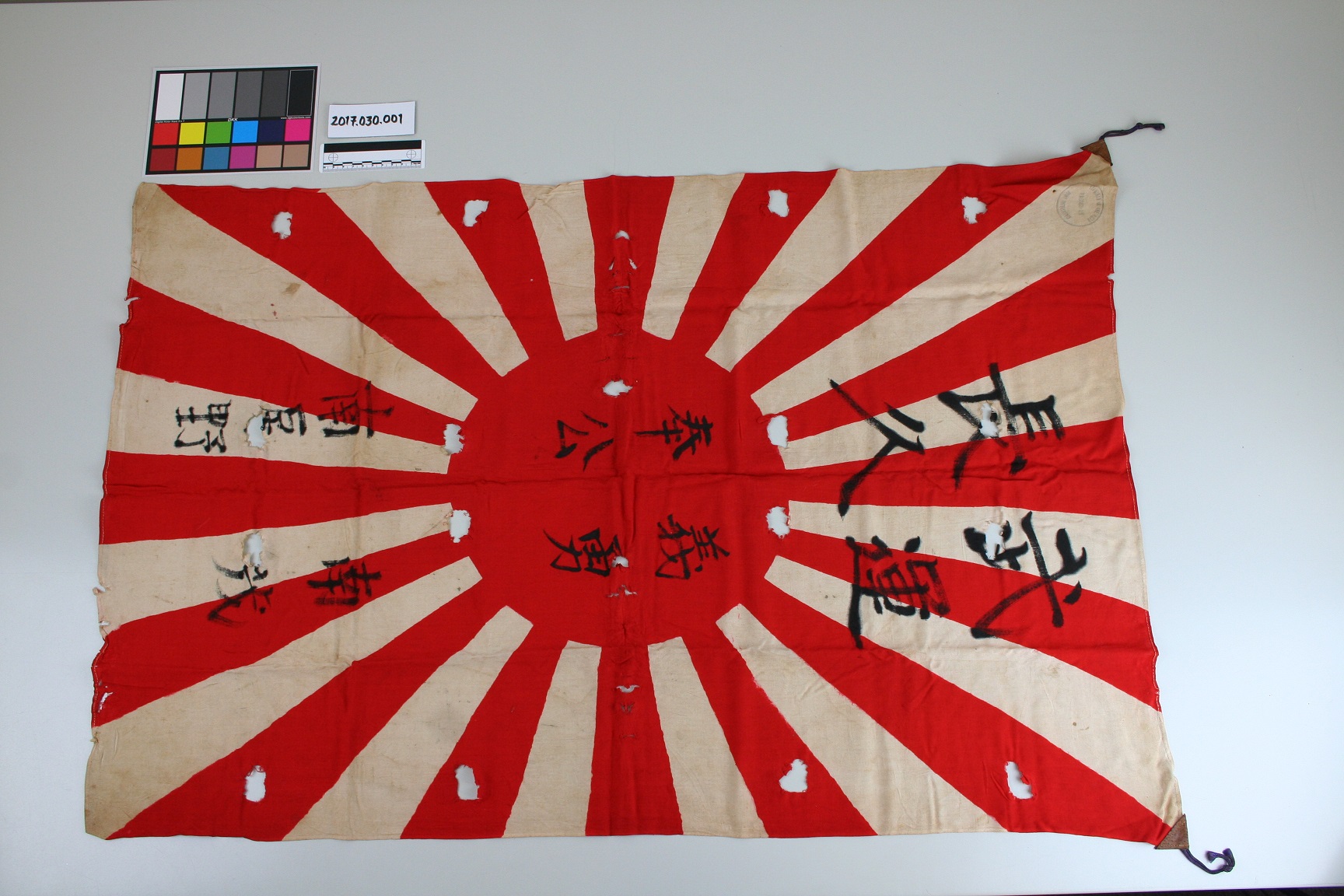 specialists, the Navy radioman kept the flag and returned home to New Orleans after the war. A few years ago, a friend of the Navy volunteer came to own the flag and offered it for inclusion in the Coast Guard Heritage Collection (seen at right).
specialists, the Navy radioman kept the flag and returned home to New Orleans after the war. A few years ago, a friend of the Navy volunteer came to own the flag and offered it for inclusion in the Coast Guard Heritage Collection (seen at right).
The family of flags, to which this specimen belongs, were very popular war souvenirs and Allied military members serving in the Pacific took thousands home. These flags were known as “Best Wishes” or “Good Luck” flags (sometimes referred to erroneously as Prayer Flags). Prior to their military induction or wartime deployment, Japanese soldiers received them from family, neighbors, fellow workers, classmates, and friends.
Most Good Luck Flags date from before or during the Second Sino-Japanese War and World War II from 1937 to 1945. In typical examples, they measure about 26 by 32 inches, but they range from small “parade” types of about seven by 11 inches, to large ones measuring three by five feet. They were personal gifts small enough to carry with the soldier and made from a variety of fabrics. Up to about 1930, they were made from silk and purchased from stores or catalogs. In addition to silk, they were made of cotton and synthetic rayon (difficult to distinguish from silk, but rayon retains color and remains intact with age). Toward the end of the war, with fabric at a premium, the flags were also made from a hemp-like material.
Using the Hinomaru, also known as the Japanese national flag (a red disk on a white field), well-wishers signed their names or wrote good luck messages, slogans and exhortations for the military member to do well in battle. The Hinomaru (hi=sun, no=is, maru=round, or literally; “the sun is round”) was officially adopted on January 27, 1870, during the reign of the Meiji Emperor, but the design was reputedly used for a 1,000 years. The pattern of flag in is often referred to as Japan’s “war flag,” with the rayed sun design used mostly by Japanese naval forces and known in Japanese as the Jyūrokujō-Kyokujitsu-ki. In addition to signatures, stamped seals may be found in red ink with seals from shrines and organizations supportive of the individual or the military in general.
With inscriptions on and around the central disk, the flag is termed “hinomaru yosegaki” (yose=sideways, gaki=to write; “to write sideways around the red sun”). Observers will see that photographs of these flags showing what Westerners consider the reverse side (Japanese military manuals typically depict this side of flags). One must bear in mind that traditional Japanese text is read from right to left and Japanese books begin from what Americans consider the “back” of the book.
These flags offered the Japanese soldier or sailor a personal connection to the hopes and wishes of family and friends. They also helped the bearer through tough times and reminded him to do his duty. During the war, the Japanese Emperor and the country were considered one and the same, so great honor fell to the family of those who died serving the Emperor. Self-sacrifice was a central belief of the Japanese culture at the time, so this frame of mind was considered natural.
Good Luck flags were often covered in writing and stamps from various sources. The writing, most often in ink from a brush, usually flowed outward from the disk in a rayed pattern, but any configuration was possible. Flag researchers often find inscriptions wishing good fortune, but there are other variations on the theme. These writings are typically executed in large characters across the top. Smaller characters in columns running vertically down the right or left margin are the names of the recipient and the individual or body presenting the flag.
For the flag in the photograph, the first two groupings of characters, at the top of the flag and in the center, are called Yojijukugo (four-character idiomatic phrases). The groupings are compound phrases constructed from four kanji (adopted Chinese characters) combined together without grammar particles, so there is often no exact translation. However, the characters on the top of the flag (the right on the first color picture) spell out a common phrase: “Bu un chou kyu” or “We wish you continued good luck in the war” 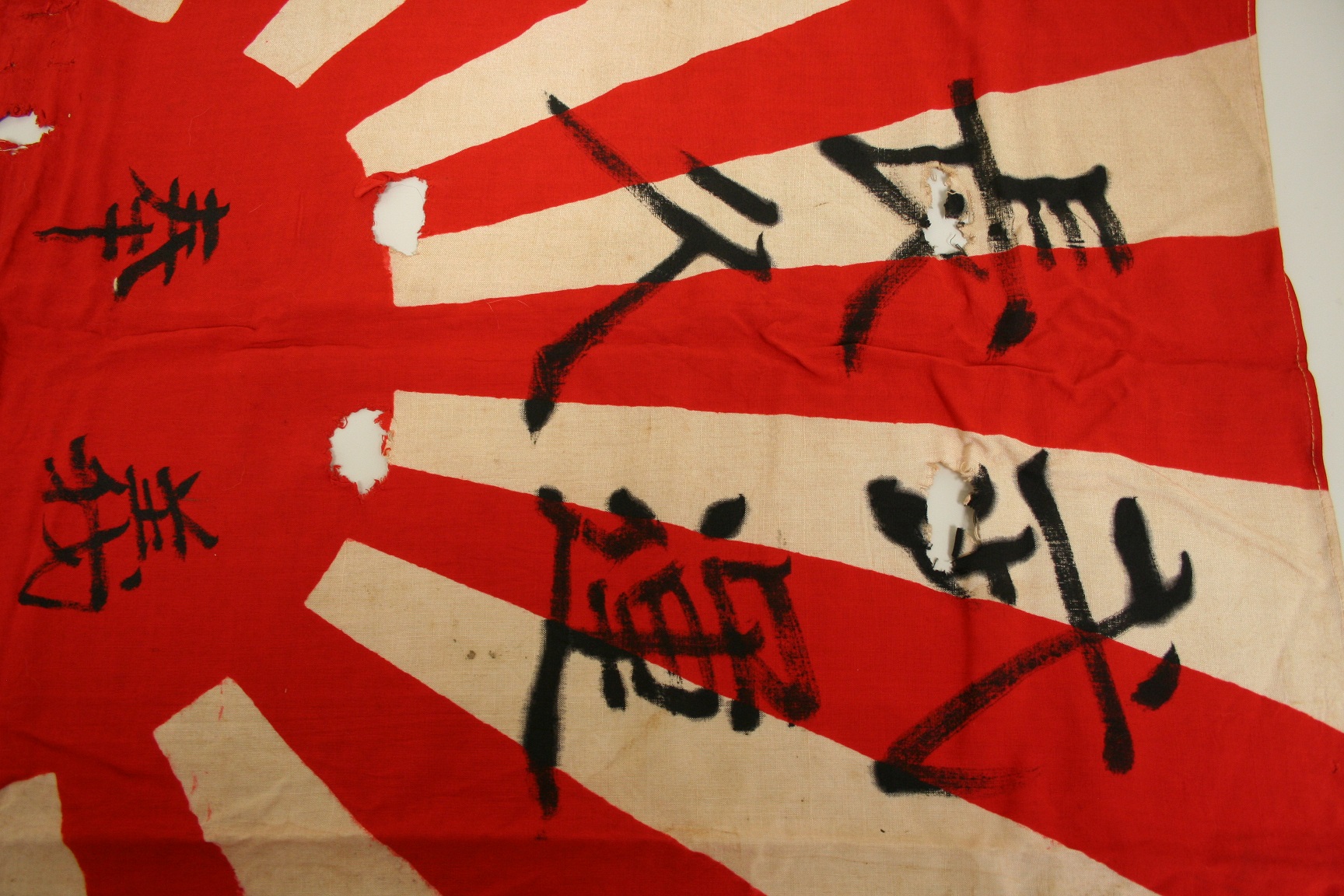 shown left. In the central disk, the characters read “Gi yuu hou kou,” or “You are heroic in your duty” seen right.
shown left. In the central disk, the characters read “Gi yuu hou kou,” or “You are heroic in your duty” seen right.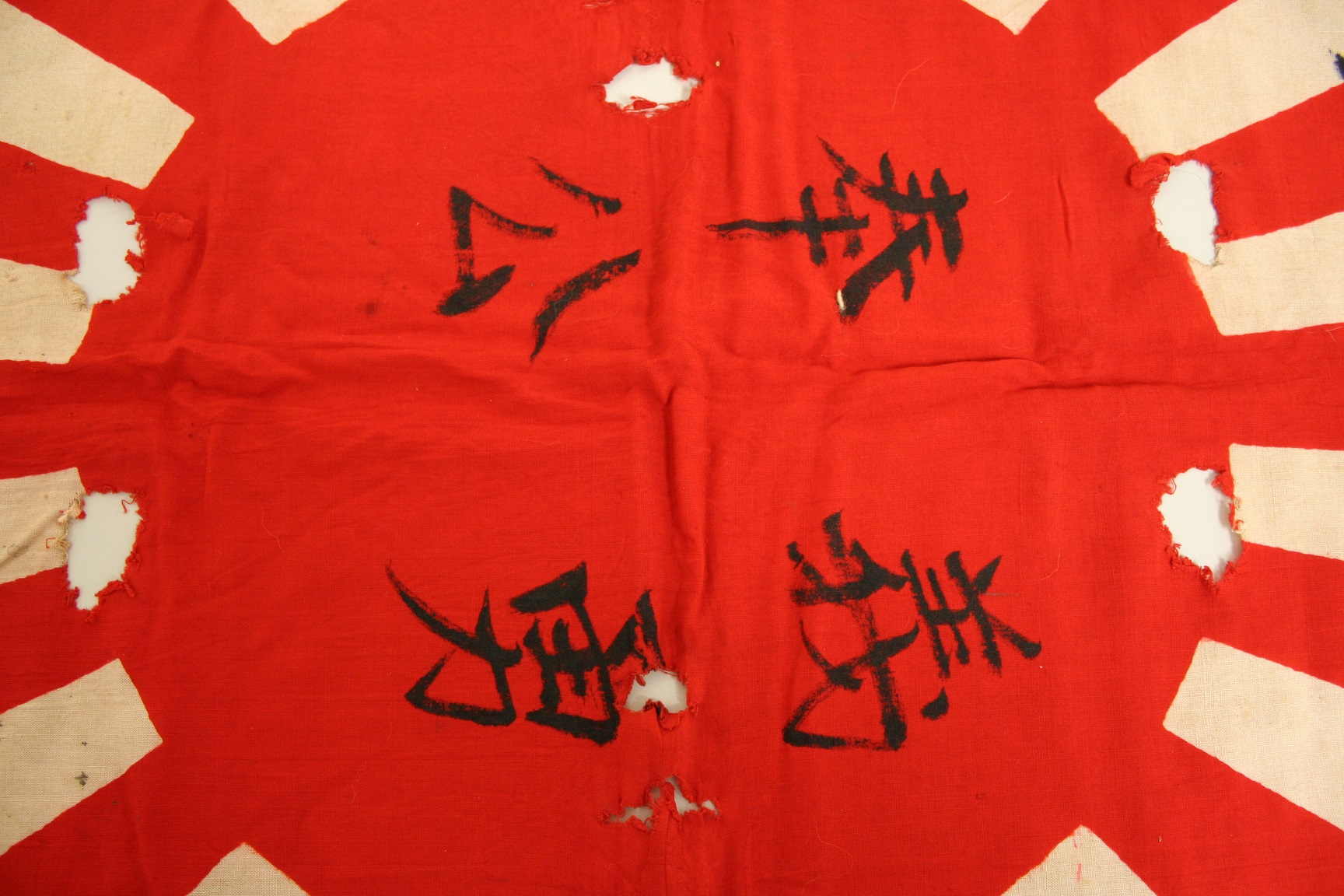
At the bottom of the flag are individual names. It appears this flag was meant for two brothers from the Minami family (the first characters and family names match), a fairly common family name. With Japanese given names, the kanji may be read several ways, so it is difficult to say for certain who the two brothers were. Using a common approach, however, a best guess would be Shigeru Minami and Fusano Minami [Fig. 6]. The flag bears no indication regarding their hometown or Japanese prefecture.
The red disc is either screened or imprinted on the field, but occasionally it is sewn or hand-painted. If the flag is the two-piece variety, it is usually made of cotton. The fly is reinforced and, occasionally, the top and bottom edges are as well. Most Good Luck flags have triangular material at the hoist corners. These reinforcements are made from various leathers, paperboard, gold or silver foils, or different fabrics. Attached at these reinforcements are tie strings of various materials. These strings enabled soldiers to secure the flag to a rifle or other object as shown in photos taken during the war (seen below to the right). The damage to the field of this flag was unexplained by information provided when it was donated to the Coast Guard. As evidenced in the photo, the damage likely occurred due to folding.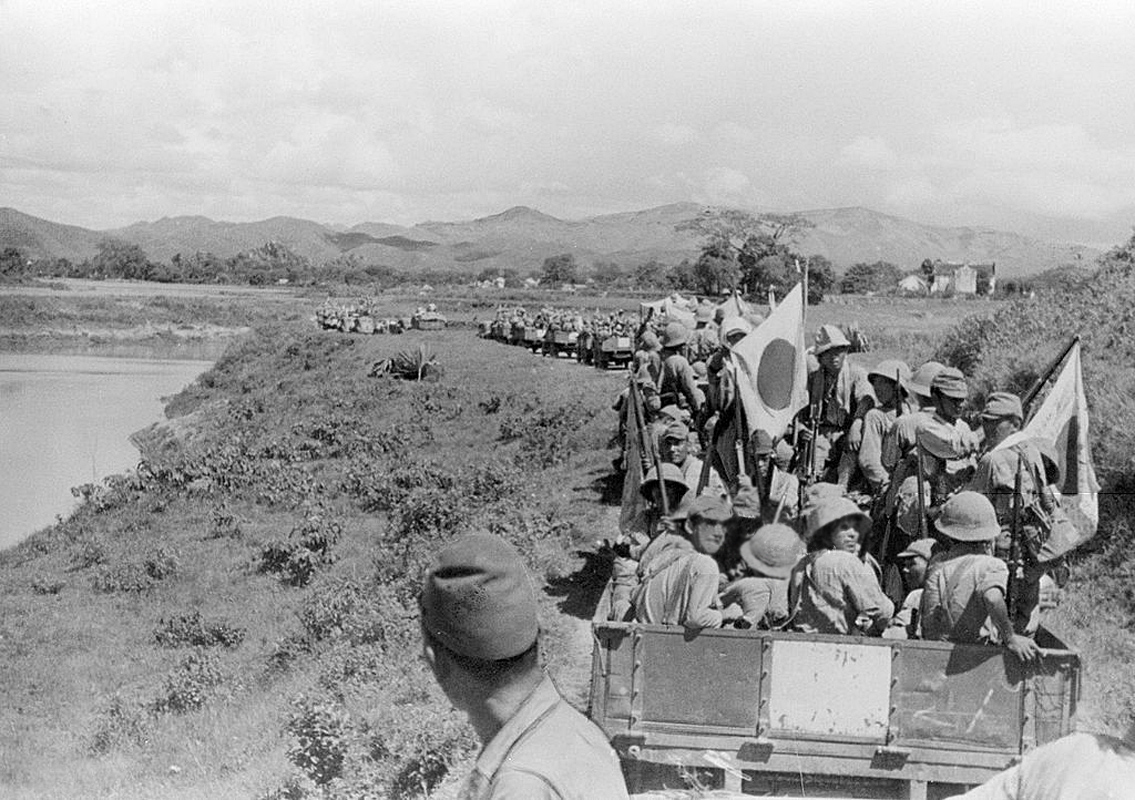
Found in military museums across the United States and innumerable personal militaria collections, Good Luck flags have recently received attention. The reason is a trend by World War II veterans and family members, collectors, and organizations, to return Good Luck flags to their original owners, families, or the communities they came from. These efforts can prove difficult because there are many common Japanese family names. Unless there are other inscriptions identifying the original bearer, it may be impossible to identify who owned it. Further, some characters used during the war are no longer used in modern Japanese language. Despite these difficulties, successes are celebrated occasionally when these personal artifacts complete a decades-long journey home.
EDITOR'S NOTE: An earlier version of this story appeared in Vexillum, a publication of the North American Vexillological Association. See www.nava.org for more Information.